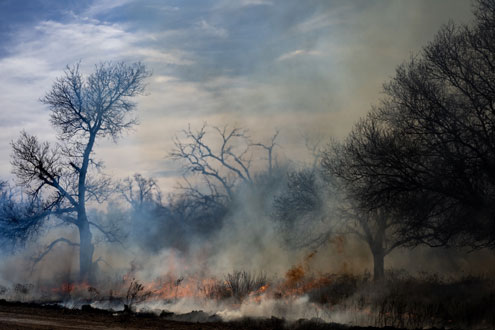With dry weather conditions increasing wildfire risk across many parts of the state, the Texas A&M AgriLife Extension Service is sharing prevention and mitigation tips to help Texans safeguard their property, operations and infrastructure.
The latest U.S. Drought Monitor indicates that much of Texas is under drought intensity. In response, the agency’s Disaster Assessment and Recovery, DAR, unit is urging landowners to act now to minimize fuel loads, protect critical structures and plan coordinated responses before fires ignite.
“Landowners need to take note of potential wildfire threats in their pastures and consider implementing prevention and mitigation practices that may limit damage that could be quite severe,” said Ryan Martin, DAR program specialist for the North Region.

Mitigation practices for property owners
Martin has several prevention and management techniques and recommendations as dry conditions continue:
Grazing practices: Utilize livestock to selectively reduce fuel loads by grazing areas with heavy grass or brush before fire season.
“Rotational grazing is another method where livestock are moved through pastures, reducing fuel loads and creating a patchy landscape to slow the spread of wildfire,” he said.
Fuel removal along fence lines: Fence lines often accumulate heavy growth of forage grasses and brush. Clearing fence lines will create a break and minimize tall, continuous fuels.
Firebreaks: Utilize natural or manmade firebreaks like roads, rivers, rocky outcrops or bare ground to create gaps in vegetation and slow the spread of wildfire, Martin said.
“Landowners can also plow or scrape an area to remove combustible material,” he said.
Community fire adaptation planning: Coordinate with neighbors, local fire departments and local prescribed burn associations to share resources and identify high-risk areas.
“Identify high-risk areas and prioritize those at the community level,” he said. “Establish evacuation routes, safety zones and lines of communication that can be shared during fire events.”
Water sources for firefighting: Ensure access to ponds, tanks, wells and hydrants that can be used by firefighting crews during an emergency.
Coordinate with neighboring landowners
“Coordination among neighbors and local fire professionals for a community-wide mitigation effort is key,” Martin said. “Regular pasture inspections and emergency plans help ensure readiness when wildfire conditions escalate.”
Texashelp.tamu.edu provides a list of wildfire educational resources to assist with monitoring and safeguarding against threats.
Wildfire Preparedness Resources
Find AgriLife Extension guides and checklists to help monitor conditions, reduce risks and safeguard your property before wildfire season peaks.


